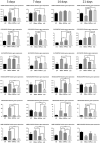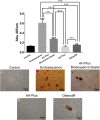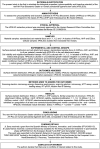Cytocompatibility and bioactive potential of AH Plus Bioceramic Sealer: An in vitro study
- PMID: 35950780
- PMCID: PMC9541143
- DOI: 10.1111/iej.13805
Cytocompatibility and bioactive potential of AH Plus Bioceramic Sealer: An in vitro study
Abstract
Aim: To assess the cytocompatibility and bioactive potential of the new calcium silicate cement-based sealer AH Plus Bioceramic Sealer (AHPbcs) on human periodontal ligament stem cells (hPDLSCs) compared with the epoxy resin-based sealer AH Plus (AHP) and the calcium silicate cement-based sealer Endosequence BC Sealer (ESbcs).
Methodology: Standardized sample discs and 1:1, 1:2 and 1:4 eluates of the tested materials were prepared. The following assays were performed: surface element distribution via SEM-EDX, cell attachment and morphology via SEM, cell viability via a MTT assay, cell migration/proliferation via a wound-healing assay, osteo/cemento/odontogenic marker expression via RT-qPCR and cell mineralized nodule formation via Alizarin Red S staining. HPDLSCs were isolated from extracted third molars. Comparisons were made with hPDLSCs cultured in unconditioned (negative control) or osteogenic (positive control) culture media. Statistical significance was established at p < .05.
Results: A higher peak of Ca2 + was detected from ESbcs compared with AHPbcs and AHP in SEM-EDX. Both AHPbcs and ESbcs showed significantly positive results in the cytocompatibility assays (cell viability, migration/proliferation, attachment and morphology) compared with a negative control group, whilst AHP showed significant negative results. Both AHPbcs and ESbcs exhibited an upregulation of at least one osteo/odonto/cementogenic marker compared with the negative and positive control groups. Both ESbcs and AHPbcs showed a significantly higher calcified nodule formation than the negative and positive control groups, indicative of their biomineralization potential and were also significantly higher than AHP group.
Conclusion: AH Plus Bioceramic Sealer exhibited a significantly higher cytocompatibility and bioactive potential than AH Plus and a similar cytocompatibility to that of Endosequence BC Sealer. Endosequence BC Sealer exhibited a significantly higher mineralization potential than the other tested sealers. The results from this in vitro study act as supporting evidence for the use of AH Plus Bioceramic Sealer in root canal treatment.
Keywords: AH Plus Bioceramic Sealer; AH Plus sealer; Endosequence BC sealer; bioactivity; biocompatibility.
© 2022 The Authors. International Endodontic Journal published by John Wiley & Sons Ltd on behalf of British Endodontic Society.
Conflict of interest statement
The authors declare no conflicts of interest related to this study.
Figures







Similar articles
-
Comparative bioactivity and immunomodulatory potential of the new Bioroot Flow and AH Plus Bioceramic sealer: An in vitro study on hPDLSCs.Clin Oral Investig. 2024 Mar 5;28(3):195. doi: 10.1007/s00784-024-05593-7. Clin Oral Investig. 2024. PMID: 38441709 Free PMC article.
-
Biological properties of Ceraputty as a retrograde filling material: an in vitro study on hPDLSCs.Clin Oral Investig. 2023 Aug;27(8):4233-4243. doi: 10.1007/s00784-023-05040-z. Epub 2023 May 1. Clin Oral Investig. 2023. PMID: 37126146 Free PMC article.
-
Biocompatibility, bioactivity and immunomodulatory properties of three calcium silicate-based sealers: an in vitro study on hPDLSCs.Clin Oral Investig. 2024 Jul 6;28(8):416. doi: 10.1007/s00784-024-05812-1. Clin Oral Investig. 2024. PMID: 38969964 Free PMC article.
-
Influence of bioceramic sealers on dentinal tubule penetration and antimicrobial effectiveness: a systematic review and meta-analysis of in vitro studies.Odontology. 2024 Jul;112(3):672-699. doi: 10.1007/s10266-024-00904-6. Epub 2024 Feb 19. Odontology. 2024. PMID: 38374511
-
Calcium Silicate-Based Sealer Dentinal Tubule Penetration-A Systematic Review of In Vitro Studies.Materials (Basel). 2023 Mar 29;16(7):2734. doi: 10.3390/ma16072734. Materials (Basel). 2023. PMID: 37049028 Free PMC article. Review.
Cited by
-
The solubility, pH value, chemical structure, radiopacity, and cytotoxicity of four different root canal sealers: an in vitro study.Clin Oral Investig. 2023 Sep;27(9):5413-5425. doi: 10.1007/s00784-023-05160-6. Epub 2023 Jul 24. Clin Oral Investig. 2023. PMID: 37486382
-
Biocompatibility of three different root canal sealers, experimental study.BMC Oral Health. 2023 Oct 4;23(1):715. doi: 10.1186/s12903-023-03473-2. BMC Oral Health. 2023. PMID: 37794396 Free PMC article.
-
Effects of radiotherapy dose and application time on the load-to-failure values of teeth filled with different sealers.BMC Oral Health. 2024 Oct 21;24(1):1260. doi: 10.1186/s12903-024-05029-4. BMC Oral Health. 2024. PMID: 39434091 Free PMC article.
-
Analysis of the cytotoxicity and bioactivity of CeraSeal, BioRoot™ and AH Plus® sealers in pre-osteoblast lineage cells.BMC Oral Health. 2024 Feb 22;24(1):262. doi: 10.1186/s12903-024-04021-2. BMC Oral Health. 2024. PMID: 38389110 Free PMC article.
-
Biocompatibility and Bioactivity Evaluation of Novel Calcium Silicate-Based Sealer: In Vitro Study on Human Dental Pulp Stem Cells.Eur J Dent. 2025 Jul;19(3):777-783. doi: 10.1055/s-0045-1802566. Epub 2025 May 1. Eur J Dent. 2025. PMID: 40311629 Free PMC article.
References
-
- Aminoshariae, A. & Kulild, J.C. (2020) The impact of sealer extrusion on endodontic outcome: a systematic review with meta‐analysis. Australian Endodontic Journal, 46, 123–129. - PubMed
-
- Arzate, H. , Zeichner‐David, M. & Mercado‐Celis, G. (2015) Cementum proteins: role in cementogenesis, biomineralization, periodontium formation and regeneration. Periodontology 2000, 67, 211–233. - PubMed
-
- Bakir, E.P. , Yildirim, Z.S. , Bakir, Ş. & Ketani, A. (2022) Are resin‐containing pulp capping materials as reliable as traditional ones in terms of local and systemic biological effects? Dental Materials Journal, 41, 78–86. - PubMed
-
- Bartold, P.M. & Gronthos, S. (2017) Standardization of criteria defining periodontal ligament stem cells. Journal of Dental Research, 96, 487–490. - PubMed
MeSH terms
Substances
Grants and funding
LinkOut - more resources
Full Text Sources
Miscellaneous

